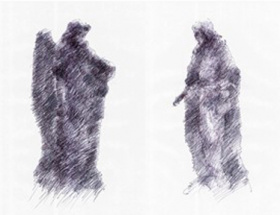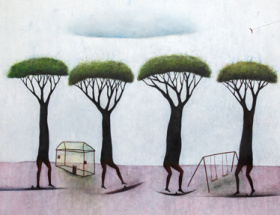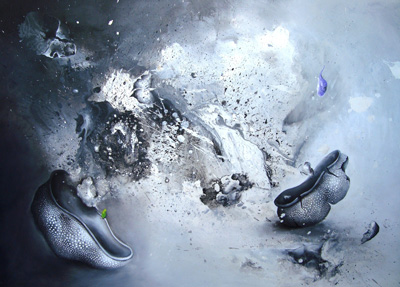[vc_row][vc_column][vc_column_text]
The Own Restlessness
By Nathalie Mesa Sánchez
«…the sculptor brings out all the superfluous and reduces the material to the form that exists within the artist’s mind”.
Giorgio Vasari
Voluntarily disturbing is the condition in which Erniel Chacón presents the work of art. An artist who works mainly sculpture and installation builds an imagery from the apparent poverty of the object. I say apparent because the definition of poor object is questionable when the artist grants it new definitions. Then it is not a work built from poor objects, but from aesthetically flimsy materials lacking “beauty».
Is Erniel anchored in the term unfinished work (a definition that comes from romanticism), or is it simply an artist more of the postmodern era who experiments with affordable solutions articulated in a solid idea and with much to say?
The materials he employs are cardboard, wood, cement, metal, and even technological elements. Creations such as Tecnología (Technology) (2010), remind me at times of works by Chuli Herrera, when he tries to make technology available to the public as a means to produce art. However, we cannot say that Chacón resembles any other artist; he is not a classic sculptor who molds and carves the material, but possesses the tools for the revaluation of the sculptural object resembling the povera, but with an imagery that pretends “to express the energetic and transforming aspect of work”, as he himself puts it.
He presents the work from what he understands as sowing or mining, and from the popular angle he works with the ball and the peasant’s ax. He is interested in the purest side of the object, without transforming it completely, without enriching it with paraphernalia and without introducing the kitsch into his machine of ideas. He is therefore an audacious artist, capable of deciding to invite us to participate in a production without embellishment, without complacency and without taboos.
His production is disturbing because of the internal processes that his work can produce in us as spectators. His greatest virtue as an artist is to try to present an ideology of his own with the helpless and the «ugly», at the same time amalgamated with substantially protected ideas. The concept of ugly is simply his most authentic reality.
Erniel inevitably flirts with the art-nature relation in many of his works, among them Transgression (2006). This piece is made up of a demolished or rather elaborated tree, according to the position in which the viewer wants to see it. This plant may be seen as the representation of lifeless nature; however, the axes and shovels attached to it are a symbol of life, of what work and effort achieve. Of what renews itself and allows the fertility of new projects.
His position of approaching work and the concern for the human being are a need of expression for him as an artist. Likewise, it is also part of an approach to a realism that since mid-nineteenth century has the intention of presenting us with a «reality» marked by subjectivity and its context. Mi voluntad (My Will) (2007) is one of the pieces already rooted in this pretext. The peasant’s boots are similar to those painted by Van Gogh in 1886 in terms of the significance of the absent: the peasant, the man of the land, and are distant, in addition to the manifestation, because of the attributes placed by Erniel: the plants, the earth. If we could categorize it, we would say that it is a continuation of Still Life with Boots or Pair of Boots by the European author, in which he adds other elements to bring the 21st century spectator to a reality that has existed for centuries, and still lasts.
But what does Erniel really want to tell us? Or is he perhaps worried by something? Without limiting ourselves to thinking that art always seeks, or at least attempts to rethink, question, dialogue, communicate, and, above all, lead us to reflection, this artist challenges the absurd concept of beauty to propose his vision of the contemporary world. We are before a representation of the coarse, and notwithstanding, it is still beautiful. We are facing a construction of works close to popular art as expression of a Cuban tradition and of course, a form of understanding their way of seeing, interpreting and representing the world.
On the other hand, Chen (2010) is a piece that works with the relationship with other cultures, amalgamated to a graceful subjectivity. In other pieces like Pico (Peak) (2017), he stops at how the object is built and not at the finished object. He is not interested in its appearance or conclusion, but in the process of conceiving the work itself, and that is what encourages us to think.
If we are concerned about his work, it is not because of the open manner in which he presents the sculpture, but because it tells us so many truths that in the postmodern era perhaps we may not have been able to stop to think. Chacón is an artist who does care about the aesthetics of the unfinished, but with a touch of his own postmodern realism, authentic and disinterested.
[/vc_column_text][/vc_column][/vc_row][vc_row][vc_column][vc_gallery interval=»0″ images=»7422,7423,7424″ img_size=»1200×692″ css=».vc_custom_1549928290590{margin-top: 10px !important;}»][/vc_column][/vc_row]



